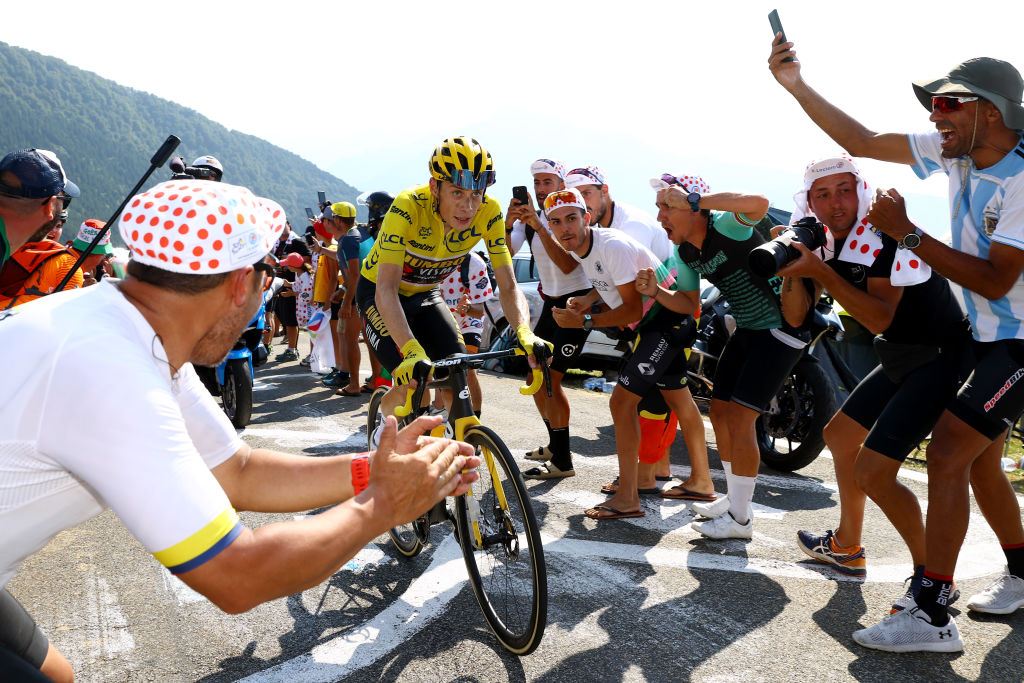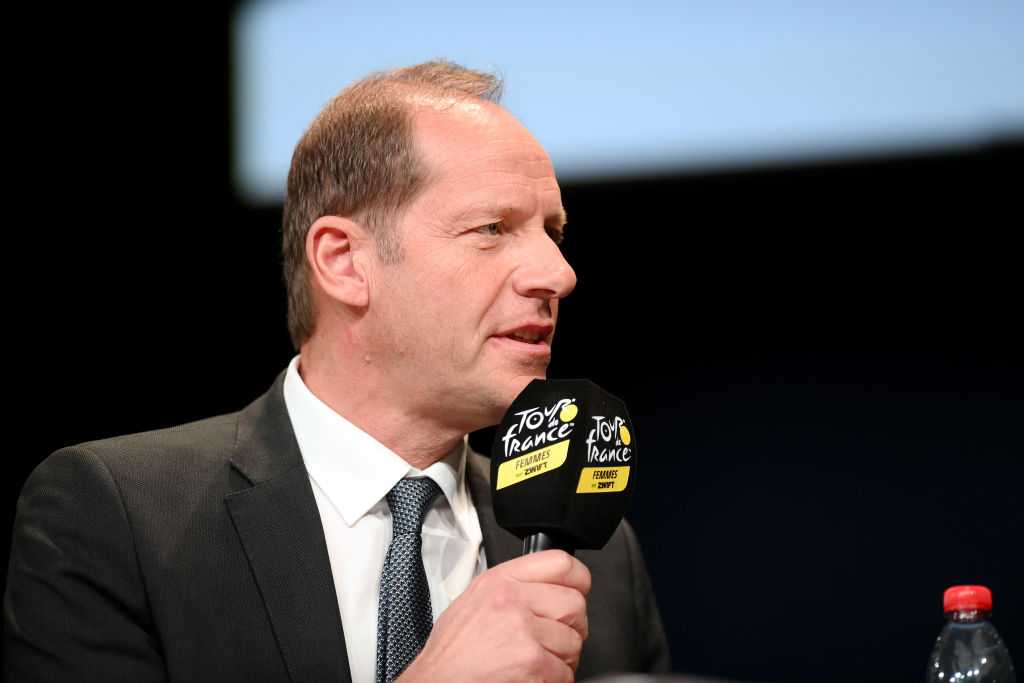A Tour de France for the Netflix generation - 2023 route analysis
ASO tries to engineer a series of cliffhanger episodes in July

"Everybody stay calm, everybody stay calm.” No fire alarm was sounding inside the Palais des Congrès, nor was there a hint of an emergency of any sort. These were, in fact, the words of Christian Prudhomme, shortly after he'd revealed the route for the 2023 Tour de France.
The race director beamingly extolled the virtues of a parcours that takes in all five of France's mountain ranges, hits a record for categorised climbs, and features headline acts like Puy de Dome and Col de la Loze. Those expecting the heavy helping of climbing to be balanced by a solid side order of time trialling, however, were left waiting and waiting, until the lights went up in the auditorium.
22 kilometres against the clock – an all-time low. Prudhomme attempted to play down this fact with reference to the 2015 Tour and its sole 14km opening individual time trial, but that fails to factor in the 28km team time trial later in the race. In terms of overall time trialling, there has never been less since the discipline first featured in 1934.
And so for all the peaks on the horizon, what was absent stood out the most. It's what Prudhomme spent most of his time addressing in the ensuing media melée. The former journalist defended his position well, voicing a surprisingly frank opinion that effectively amounted to ‘it's boring,’ and arguing that time trials don't work in the modern age of the all-rounder.
The call for calm came when Prudhomme was set upon by a pair of Belgian reporters. His press officer was attempting to usher him to safety backstage, but they demanded to know why he hadn't served up a route more amenable to their star, Remco Evenepoel. This was something of a national affront. Did he not want the world champion to race the Tour?
Prudhomme played this expertly.
"La Redoute, I don't think was a time trial," he said, referring to Evenepoel's solo victory at Liège-Bastogne-Liège this spring. "San Sebastian wasn't a time trial. The World Championship wasn't a time trial.”
Get The Leadout Newsletter
The latest race content, interviews, features, reviews and expert buying guides, direct to your inbox!
“We're waiting for him," Prudhomme added, pointing out that Belgian five-time Tour winner Eddy Merckx only made his debut in 1969 at the age of 24 after three appearances at the Giro. "Let's all stay calm, even you, stay calm. If he comes in 2024 at 24... remember Eddy Merckx, 1969... stay calm kids.”

What are they trying to achieve?
Beyond Evenepoel, there were justified question marks over how a Tour de France so light on time trialling looks, and, more importantly, why.
In that respect, Thursday's assault was just the latest in the war on time trialling waged by Prudhomme. It's what his tenure as race director of the Tour could well come to be defined by. He took on the mantle in 2007, a year when the Tour featured 117km of individual time trialling, and after a decade in which the figure didn't drop below 74km.
The decline was swift, despite the 2012 anomaly, and it really gathered pace when Chris Froome's dominance hit its peak through 2015-2017. That 2017 Tour featured 37km against the clock, then 31km in 2018, 27km in 2019, and 36km in 2020. The past two years have bucked that trend, but even so, 58km in 2021 and 54km this year would be light by the standards of the 1980s, 1990s and 2000s. As if to bait the rouleurs even more, the sole time trial in 2023 takes place in the Alps. "It's not one for Filippo Ganna," Prudhomme joked.
So what are the Tour organisers, ASO, actually trying to achieve here?
It all comes down to spectacle. During the Froome years, marked by the suffocating dominance of Team Sky, Prudhomme felt starved of it. Now, he appears in awe of what he sees as a new generation of all-rounders such as Tadej Pogacar and Wout van Aert, who are veering between the traditional lanes of the Tour. There has certainly been a general trend towards this all-action, no-tomorrow style of racing in recent years and Prudhomme is eager to embrace it.
Having riders setting off one by one, he openly suggested, is not exciting for spectators. He also argued that the age of climbers and rouleurs variously gaining and shipping time on each other's turf was a thing of the past. Given the two best time triallists at the 2022 Tour were also the two best climbers, it seemed a fair argument.
The case for time trialling's defence is that it creates differences between the contenders that they then have to set out to reverse. A Tour with no time trialling could in theory, become a tight waiting game, where the Tour boils down to one key moment and, possibly, bonus seconds.
Prudhomme dreams of a tight Tour, but hates the idea of a boring one. There is a balance to strike but this is a risk he clearly feels is worth taking given the showmen he sees in the current peloton.
Punchier climbs
But this is not merely an anti-time trial agenda. Even the climbs look different. Yes, there are five ranges and a record 30 categorised climbs the 2023 Tour but there aren't many of what you'd call traditional set-piece high-mountain stages.
There'll be only the briefest foray into the Pyrenees, while the longer stint in the Alps is notable for its paucity of typical ski resort roads that wind steadily up mountainsides at 6-7%. The Col de Joux Plane is an irregular beast with an average of nearly 9%, while the Col de la Loze is steeper and narrower still on the bike path near the summit. The Puy de Dome at the end of the first week and the Markstein finish on stage 20, are designed to offer more stiff climbing tests away from the long, grinding high mountain passes.
If the Col de la Loze stage weren't so utterly brutal – with more than 5,000 metres of elevation gain – you could nearly call it a puncheur’s Tour.
“On a constant climb the riders can calculate their watts and control their effort," said technical director Thierry Gouvenou, reviving another recent ASO theme, an aversion to power meters. "We are looking for ways to blow up the peloton."
Even if ASO were lobbying for a ban on power meters back in the Froome era, the idea for this kind of Tour arguably took hold when Julian Alaphilippe lit up the 2019 race and almost won it. We're not quite at the point where an Alaphilippe, Van Aert, or Van der Pol could realistically win the Tour, but on this evidence, it's perhaps not the unthinkable proposition it once was.
In essence, the organisers want (in a phrase that doesn't translate so poetically) lots of 'moments forts' and no 'moments morts' – lots of ‘strong moments’ and no ‘dead moments.’ They want an explosive Tour that's alive and open every day, even in the places you might not expect.
The prospect of eight sprint opportunities may seem high in that respect, but there’s almost no chance of that figure actually coming to pass, with tempting terrain for breakaways and the likelihood that the Loze stage will remove the pure sprinters from the race before the final three.
The fact that Netflix are on board, currently working on a docuseries to air next spring, feels particularly relevant here. In an age where sport is veering towards the shorter formats, the Tour remains at 21 stages but is sending out a plea to the modern viewer with the promise of drama and cliffhangers.
Of course, this is only to delve into the organisers' intentions; what kind of race this route actually ends up producing is another matter. It's genuinely hard to predict. It feels like it could go either way.
In any case, it's the riders who will make the race, as the cliché goes. In that respect, it's worth noting that ASO's previous attempts to liven up the Tour – steeper gradients (2017) included – had relatively little impact. The Tour has arguably been a victim of its own success in recent times, as its towering importance leading to uniformity of form and tactical conservatism. Can any amount of route-bending undo that?
The 2023 Tour will provide more robust evidence on that front. It will be a crucial experiment in coding the DNA of the modern Tour de France.
Patrick is a freelance sports writer and editor. He’s an NCTJ-accredited journalist with a bachelor’s degree in modern languages (French and Spanish). Patrick worked full-time at Cyclingnews for eight years between 2015 and 2023, latterly as Deputy Editor.
